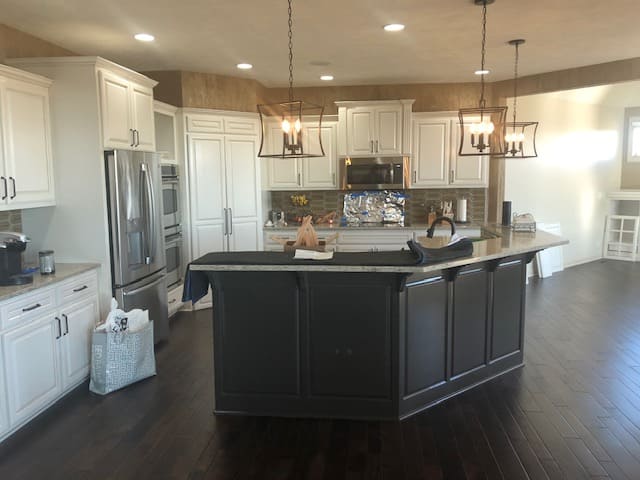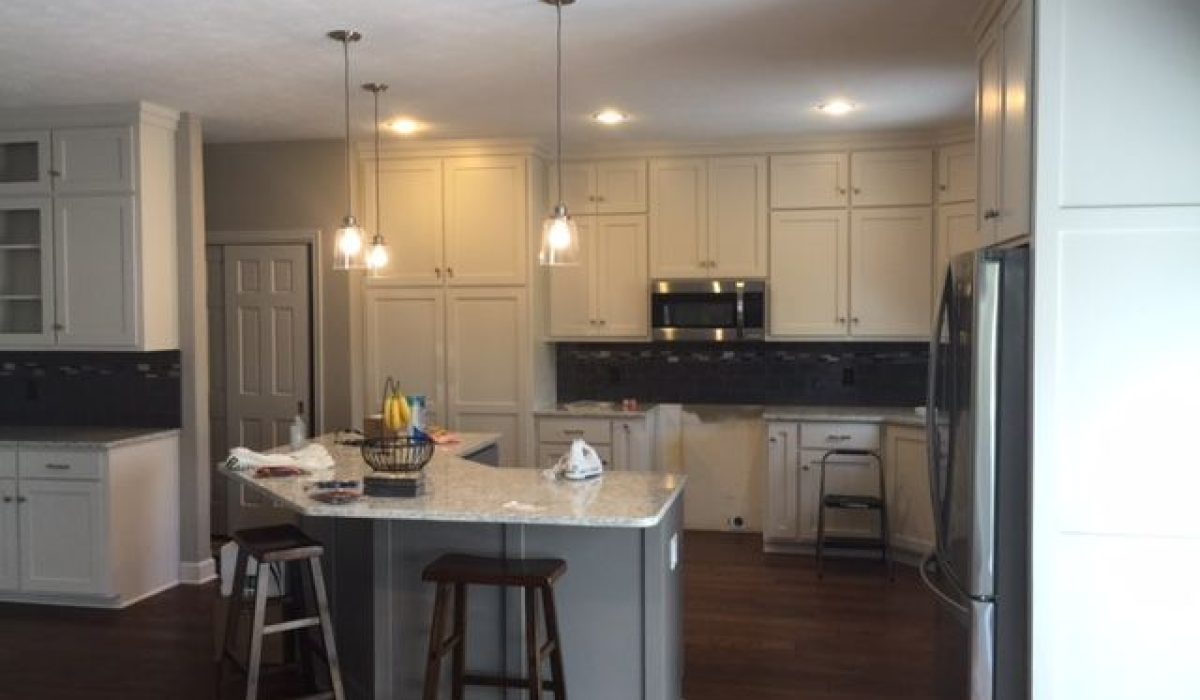Whether you are painting new cabinets or repainting existing ones. Doing it yourself or hiring a professional. Professional cabinet painting is a niche within the paint contractor community. There are not many painters that really know what it takes to do cabinets right. Here is everything you need to know. Pro or novice.
Anyone that reads this article will dramatically reduce their learning curve when it comes to painting cabinets.
I have had very experienced painters come to work for us and while they had many skills they were not knowledgeable about doing cabinets the right way. There are basic steps every cabinet job has regardless of the type of material being finished.
- understand the material being finished.
- Gather your materials.
- prepare the area and the cabinets for painting
- paint the cabinets
- clean up

Understand the material being finished
Cabinets come in all shapes and sizes. They are also made from various materials. Typically from a variety of wood. Oak, maple, birch, pine … They also come in other types of materials like MDF (medium-density fiberboard) HDF (high-density fiberboard) also referred to as masonite, melamine, metal, etc. The material being painted will in large part determine the primers and paints to be used. Whether the cabinets have been previuosly painted or stained will also influence what materials to use.
What is most common in Omaha and the surrounding communities is wood cabinets that have been previously stained and lacquered or new unfinished wood cabinets.
Gather your materials
There are many items that are needed when painting cabinets. Of course you will need primer and paint but there are many additional items needed as well.
You will need rosin paper for covering counter tops and floors.
Tape. We use both high tack and low tack. The high tack is used on floors, counter tops and on items that will not be harmed by a high tack tape. Low tack tape is used on walls and other surfaces where a stronger or high tack tape might damage the surface. The two tapes we like are PG29 which is a low tack tape and Suretape which a high tack product. We use 1/2″, 1″ and 2″ depending on what we are masking.
Masking paper. Masking paper comes in many different widths. We use 6″, 9″ and 12″ paper.
A masker is necessary too. I can’t imagine trying to tape off cabinets without one.
Drop film is needed as well. This is a roll of plastic you put on your masker and it will unfold to different lengths. 2′, 4′, 6′, 99″. This is used to cover larger areas like windows, doorways, sections of walls, etc.
Roll plastic. We use rolled plastic to create plastic barrier walls to contain the work area (kitchen) We normally use 2ml thick plastic but many different thicknesses will work as well. Just don’t use really thin plastic. It will tear too easily. We partition off the areas with the help of Zip Poles.
Zip Poles are adjustable poles that come in handy when trying to partition off an area.
Denatured Alcohol. This is our go to solvent for cleaning greasy/dirty items.
Sand paper. We use both sanding sponges and sheets of sandpaper. Several different grits will be needed. 60 grit through 440 grit. We go through a lot of sandpaper. Sanding blocks are handy as well when using sheets of sandpaper.
Spackle. Crawfords is nice. I am also a fan of the 3m spackle that has a primer agent in it as well. We still prime when using it but the extra oomph is nice.
Drop Cloths. We use these for covering items as needed like a refrigerator, stove, floor, etc.
Lights. It is common to need additional lighting when working in a kitchen for example.
Airless spray rig. We use Graco pumps mostly. A 395 or 495 is what we use on most cabinet projects. You will also need the right gun and tip. We use fine finish tips. The type tip is normally dictated by the products being sprayed. A 310 or 312 is common.
Glazing putty. Bondo or automotive/body shop type. We use this for repairs, filling in holes, etc.
Stain Sealer. A puff can or aerosol type works best. You definitely want an alkyd or solvent type for sealing stains, tannin bleed, etc.
Miscellaneous stuff. Empty buckets, extension cords, screw guns with various screw bits, a marker or sharpie, fans, step ladders, rags, dust masks, rubber gloves, paint brushes, wennie rollers and covers, cardboard, etc.
Prepare the area and cabinets for painting
Furniture needs to be moved out of the area. Tables, chairs, etc. Counter tops completely cleared off. Knick knacks, decorations on top of cabinets removed. The floor is protected. We prefer to completely cover the floor from corner to corner with rosin paper. Some contractors use drops. This is a mistake. They move and don’t protect the floor well.
Remove the cabinet doors and drawers. Be sure to label where they go. All hardware is removed from the doors and drawers. Tracks inside the cabinets are removed. The door and drawer openings are masked off with the masking paper. We work on the doors and drawers in our shop and spray them in our spray booth. If you don’t have one then you will need a work area set up outside the primary work area (kitchen). A basement, garage, etc. You will need to protect this additional work area as you would the kitchen. Floor protected, etc.
Walls, counter tops, appliances need to be masked off. We usually move the refrigerator out of the area when possible and leave the stove, dishwasher, sink, microwave open for as long as possible so these items can be accessed while the prep work continues. Pay special attention to water lines that run to a refrigerator. They can leak. We cap the line off and turn the water to that water line off when possible. Everything needs to be protected/covered. This is where you would use the PG29 tape to mask off walls or ceiling sections as needed. Best to use masking paper near the spray area and drop film (plastic) further out and away from the spray area if needed.
Erect plastic barriers. Zip walls. We do this to contain the dust and spray to within the area being worked on. There is a doorway to come in and out of the area as needed.
Fans are put into the work area for airflow. Extension cords are run to the fans and taped down or secured to prevent tripping.
Cabinet doors and drawers
The Doors and drawers have been labeled and removed. The doors and drawers go to our shop (if we are doing the job) If there is not a shop to move them to then a separate area must be established to work on these as previously stated. It is important to remember that the temperature must be controlled. It needs to be heated in the winter and cannot be hot and humid in the summer. Unfinished basements or garages can sometimes work. Between the two you are better off with a basement because of temperature problems in garages.
The following occurs concurently.
The work done on the doors, drawers and cabinets happens at the same. It’s just done in different locations. For us, we work on the doors/drawers in our shop while work is being done on the jobsite.
Cleaning. The doors/drawers and the cabinet boxes are cleaned. Denatured alcohol works very well. It is important to switch out the rags often. Some surfaces (curved or intricate) get cleaned with alcohol and a small brush. Special attention must be paid to cabinets near cooking areas as they usually have a buildup of cooking oils/grease. It is important to determine if the cabinets appear to have been cleaned with anything that may have left a wax residue like pledge, oil soaps, etc. This residue must be removed.
Repair work. If there is repair work that needs to be done. Now is the time to do it. Deep scratches, damaged doors, delaminating wood. Cabinet repair knowledge and basic carpentry skills wre needed. Autobody glazing putty is effective with damaged areas or scratches that need to be filled in. Clamps and glue for delaminating areas.
Now is also the time cabinet pull holes would be filled in or drilled for new pulls. If that is desired. We use an epoxy filler when filling holes.
Sanding. Proper sanding is very important. On cabinets that have been previously stained and lacquered, it is important to not over sand. Oversanding is very common. You want to break the finish without going all the way down to the stain. If you sand too far down you will likely have to seal the areas because of bleed through. On unpainted wood you want to sand enough to open the grain of the wood. Other types of materials may not need much, if any, sanding. When the sanding is complete it is important to dust off everything and vacuum up all the dust. It is a good idea to brush off all surfaces to be sure there is no remaining dust.
Caulking. There is quite a bit of caulking that goes into the typical kitchen cabinet job. Doors get caulked on the majority of projects unless there is no profile at all on the door. Crown molding at the top of cabinets is another area for caulking. This is also the time to do any minor putty work on small nail holes or minor blemishes. We use a rather fast drying caulk so we can move straight into priming when done.
Priming. Once everything is sanded and dusted, it is time for priming. With a sprayed finish it is important to spray everything. You can’t brush the primer or anything else and not expect to see brush marks. This also holds true after everything is sprayed. You can’t go back into the finish with a brush and not expect to see brush marks. In the spray booth we spray the backs first and then circle back to spray the fronts. At a residence we spray all the cabinets and about the time we are done the first pass it is time for the second. We use an acrylic modified urethane that dries very fast so a second coat can be readily applied. If we are doing a project that the customer does not want to see the grain in the wood or wants to reduce the amount of visible grain, we will switch to a sandable high build primer. We will use this to fill in as much of the grain as the homeowner wants. The product we use sands very well and does the job perfectly. If the objective is to not fill in the grain or if the cabinets don’t have any we will only do one light coat of building primer. After the first coat of primer has been applied it is time to look at everything for any stains or bleed through. Now is when stains, grease and bleed through will show. If they do they should be sprayed with a sealer. Do not brush a sealer or primer on these areas. It will show through the finish.
More Sanding. The primer coats need to be sanded to a uniform smooth finish. Any remaining caulking or putty work would be done now. Everything should get a hard look. Pay particular attention to cross cuts or areas with open grain like the edge of doors. These areas may need additional primer to fill the voids.
Finish Coat Time. The finish coats are now sprayed. Spraying is more art than science. We do the door backs first as we did with the primer. We will lay successive layers of finish to achieve the perfect look. Normally it is about three coats of finish.
Assembly time. Masking is removed from the drawer and door openings. Drawer glides (tracks) are installed. Drawers put in place. All the doors are installed with the proper hinges. Drawer and door nobs or handles are installed. New drawer and door silencers are placed on the backside of drawers and doors. The remaining masking is removed from appliances, walls, counter tops, floors.
Final Touch Up. All areas are looked at closely for any needed touch up. Cabinet to wall areas, floor to cabinet areas, etc. Any needed touch up work in done now.
Taking care of freshly painted cabinets is important if you want them to last as long as possible and look their best. Here are some things to remember:
After the paint has dried for at least 24 hours, you can begin using the cabinets. This will give the paint time to fully dry and harden, making it less likely to chip or scratch. Some coatings will feel dry but may actually take a week or more to fully harden.
Clean the cabinets when needed with warm water and a mild soap. Don’t use harsh chemicals or scrubbers because they can damage the paint.
Clean up any spills or splashes right away. When left to sit, water, oil, and other liquids can damage the paint.
Use coasters to keep heat from damaging the cabinets. If you put hot pans and dishes right on the paint, it can bubble or peel.
Be very careful with chemicals and cleaning supplies. Some products can make the paint chip or fade.
Don’t let direct sunlight or UV rays hit the cabinets. This can cause the paint to fade or turn yellow over time.
With proper cleaning and up-keep you can keep your newly painted cabinets looking like new for a long time.


